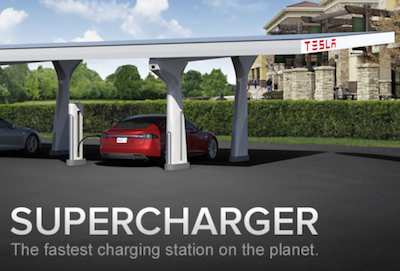Advertising
Solar Supercharger for Electric Cars
Posted on Oct 16, 2012

Actually, that day has arrived. Today there are six Tesla Supercharger electric car fast charging stations up and down the California coast, each no more than about 150 miles apart. At the 90 kW dual direct charging speeds these stations can achieve, your Tesla Model S could be 75% charged in just 45 minutes while you enjoy lunch or a snack and coffee. With the car charged up you'll make another 200 miles to the next charging station in the sublime quiet and comfort of your very own electric car.

If this is the state of the technology today, just imagine how it will evolve over the next ten years. To try to understand how quickly things can be expected to improve, we need look no further than the IT revolution that has transformed our lives over the past twenty years. Processor speeds, disk space, memory, and all else electronic and silicon based are improving at a rate called Moore's Law. "Moore's law is the observation that over the history of computing hardware, the number of transistors on integrated circuits doubles approximately every two years." (Wikipedia, 2012). A similar observation is emerging for solar photovoltaic panels, computer energy efficiency capabilities, and battery storage capacities, all of which are key ingredients of the solar electric car charging infrastructure that is popping up around the world.
Pumping electrons into an electric cars battery system is as old as the automobile itself. Electrical engineers have many wonderful parameters to work with. First of all there are two variations in the use of electricity, AC (alternating current) and DC (direct current). Each has certain advantages and disadvantages. Each may have a place in the supercharging infrastructure of the future depending on a number of factors. An important factor is the necessity to use DC for electricity battery storage. Having said that the "inverter" device, long a staple of the off-the-grid house, and many other applications, is quite capable of converting DC to AC as required, with increasing levels of efficiency. Solar photovoltaic panels that cover the Supercharger stations also operate using DC, making conversion unnecessary in some circumstances. Of course the other factors that engineers are using to optimize battery charging systems include, series and parallel DC configuration, allowing for a broad array of optimization opportunities. Series and parallel allow for solar panels and battery systems to be combined in chains, increasing or decreasing their levels of voltage output and/or amperage. In addition, depending upon these configurations, the batteries may be able to be charged in parallel as is the case with the Supercharge.
"The overarching purpose of Tesla, and my personal reason for funding the company, is to expedite the move from a mine-and-burn hydrocarbon economy towards a sustainable, solar electric economy." - Elon Musk, Tesla Chairman, Product Architect and CEO
All this techno mumbo jumbo putting you to sleep or confusing you? The point is that these technologies are ripe for the application of Moore's Law, in perhaps a slightly different formulation, however, in comparable levels of increasing speed and capacity. The stakes are very high for companies like Tesla, who are bringing some of the greatest advances in this technology. Of course, it is these "pure" electric car companies that have the most at stake while not being burdened by the potential downside of poaching from their older fossil fuel based business. Hang tight, get into your favourite electric car as soon as possible, and let us all get Supercharged with clean green electricity from solar panels. Now it is up to us to create the personal power revolution that this makes possible.
At 90kWh of stored energy, these new electric cars, and their related charging infrastructure, provide a massive moving storage and generation infrastructure, allowing renewables to go far beyond their conventionally assumed limits of 20-30% of overall generation. Now, with this increasing battery storage stock, interconnected with the grid in a two-way configuration, our cars can play a very important role in allowing for renewables to reach 100% of all of our energy needs. The six Tesla Supercharger stations now available in California prove that we have the technology and we can win the future.
For more information about Tesla, Model S and Supercharger, please go to the Tesla web site: www.teslamotors.com.
Photo Credit: Tesla Motors, please refer to their Terms of Use for further information.